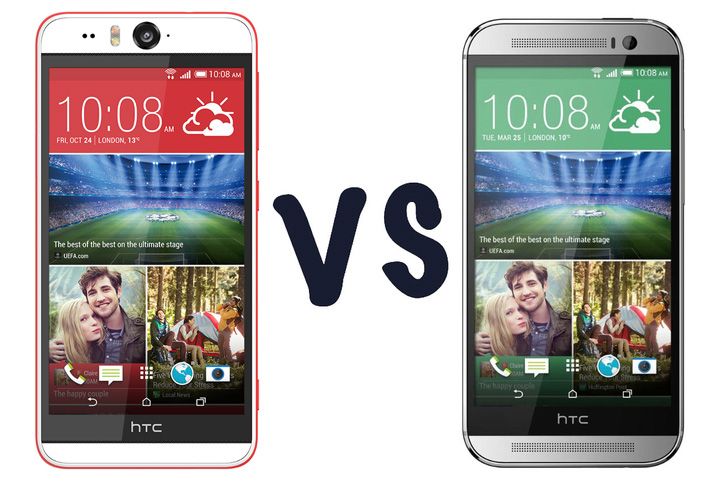HTC has announced a new smartphone that plans to take full advantage of the selfie craze with its 13-megapixel front-facing snapper and dual LED flash.
The HTC Desire Eye made its debut at the Double Exposure event in New York alongside the HTC Re camera, but how does the new selfie smartphone compare to HTC's award-winning One (M8)? We've crunched the numbers to see what the differences are.
Bigger display on Desire Eye
The HTC Desire Eye comes with a 5.2-inch display compared to the 5-inch screen you will find on the HTC One (M8) and both offer a 1920 x 1080 pixel resolution.
The HTC Desire Eye has a slightly lower pixel density than the HTC One (M8) due to its increased size - 423ppi for the Desire Eye and 440ppi for the HTC One (M8) - but we're not sure you'll notice the difference when looking at it. Both devices have a lovely display on them.
Desire Eye is plastic, waterproof, slimmer and lighter
Design is one of the areas where these two devices follow a different path, with the Desire Eye featuring a plastic, colourful, body compared to the HTC One M8's acclaimed metal build, but both feel solid and well-built.
The HTC Desire Eye measures 151.7 x 73.8 x 8.5mm and hits the scales at 154g, while the HTC One M8 measures 146.36 x 70.6 x 9.35mm and weighs 160g, meaning the new smartphone is thinner and lighter but larger in terms of its actual footprint. The Desire Eye has a flatter design, with the One (M8) having a back that's curved.
READ: HTC Desire Eye preview: A phone that wants to redefine the selfie
You'll also be able to dance with the HTC Desire Eye in the rain or have it accompany you in the bath as it carries a waterproof rating of IPX7. Although HTC doesn't advise you to use it underwater, it will deal with water better than the HTC One (M8), which carries an iPX3 rating.
More megapixels on the Desire Eye
Another area these two devices offer significant differences is the camera.
The Desire Eye steps away from the UltraPixel and Duo Camera and with a 13-megapixel front-facing and 13-megapixel rear-facing camera, compared to the 5-megapixel front camera and UltraPixel Duo Camera on the HTC One (M8).
Aside from the megapixel differences, both the HTC Desire Eye and HTC One (M8) rear cameras feature a BSI sensor, 28mm lens and an f/2.0 aperture with Full HD video recording capabilities, while the front facing cameras also opt for a BSI sensor, HDR and 1080p video recording capabilities.
READ: HTC Sense 6.0 camera update: Welcome to the HTC Eye Experience
The HTC Desire Eye front facing camera brings dual LED flash to the party too, as well as autofocus and zoom and there is also a dedicated camera button, which will make capturing images easier on the new device.
Same processor, software and connectivity options
In terms of performance, the HTC Desire Eye and HTC One (M8) sit neck-in-neck with a 2.3GHz Qualcomm Snapdragon 801 chipset under the hoods, both with 2GB of RAM and 16GB of internal memory that is expandable via microSD up to an additional 128GB.
They also feature the same connectivity options with both offering 4G LTE compatibility and the usual suspects including Bluetooth 4.0, NFC, Wi-Fi and DLNA all on board, plus both the HTC Desire Eye and HTC One (M8) run on Android with HTC Sense software so you'll get the same user experience, although Eye launches with some additional camera functionality, due to roll-out to the M8 in the future.
Smaller battery capacity on the Desire Eye but same talk time
There is a 2400mAh battery capacity on the HTC Desire Eye compared to the 2600mAh battery capacity on the HTC One (M8) but HTC claims the 3G talk time for both handsets is up to 20 hours.
We were impressed with the battery life on the HTC One (M8) so if the HTC Desire Eye manages the same or similar performance, it will be more than enough to get you through the day, but that larger display and lower capacity might cut the endurance down a little.
Conclusion
The HTC Desire Eye and HTC One (M8) sit on the same bench when it comes to many of the specs including the same processor, RAM, storage capacity, and software.
There are a couple of key differences though. The design of the two handsets sets them apart, with the M8 having the more premium look and feel. Then you have a camera experience that's almost entirely different.
The front-facing 13MP camera dominates the design and offers some nice enhancements like autofocus, although we've still got plenty of testing to do to determine it's overall performance. The rear camera changes too, with a more conventional approach on the Eye. You lose the Duo Camera features, but you gain resolution.
A price for the HTC Desire Eye has yet to be announced but we suspect it will be around £350, which makes it a lot cheaper than the One (M8). You get much the same experience on both devices, but the older handset has the edge on premium design.

